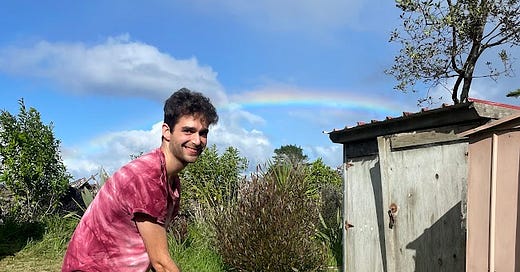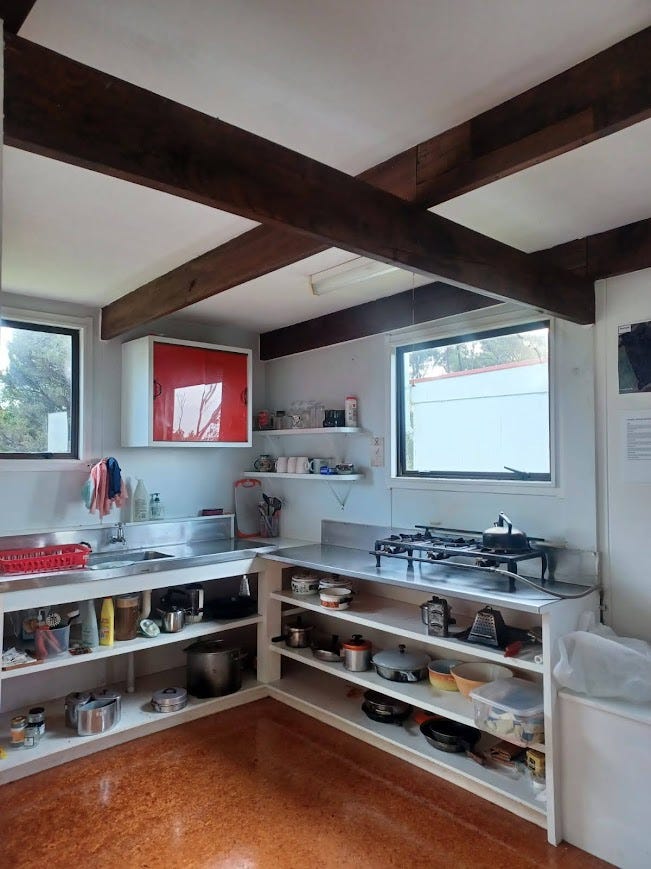Hi from Taupō, where we are working truly the most chaotic ice rink jobs. I initially joked that we had gotten jobs that people in a rom-com would have, but now I’ve become convinced that behind every cliche seasonal setting is actually just someone else’s employment fiasco. Consider this a sneak peek! But first, we have some things to catch up on! When I last wrote, we were up in the Far North of New Zealand (Pukenui, to be specific) spending a week on a wetland restoration project.
After loving our jobs as trappers, we were on the lookout for another conservation-related job or volunteering gig. We reached out to a few different organizations, including Forest & Bird, which is one of New Zealand’s largest conservation organizations. They recommended we contact their regional branches to see if they had any opportunities. We emailed a few on the North Island in places that we hadn’t been to yet, and the Far North Branch got back to us. They manage a reserve and an off-grid cabin about an hour south of the northernmost point of the North Island, and were open to having some volunteers stay!
We arrived at the Arethusa Reserve on a Monday morning, after a weekend visit to The Hundertwasser Art Center (his Seussical buildings are a must-Google for my architecture-loving friends) and camping on the beautiful Karikari Peninsula. As our arrival concluded about three weeks of gradual travel from the South Island up to the North, I showed up a bit exhausted and ready for our first week sleeping indoors in a few months!
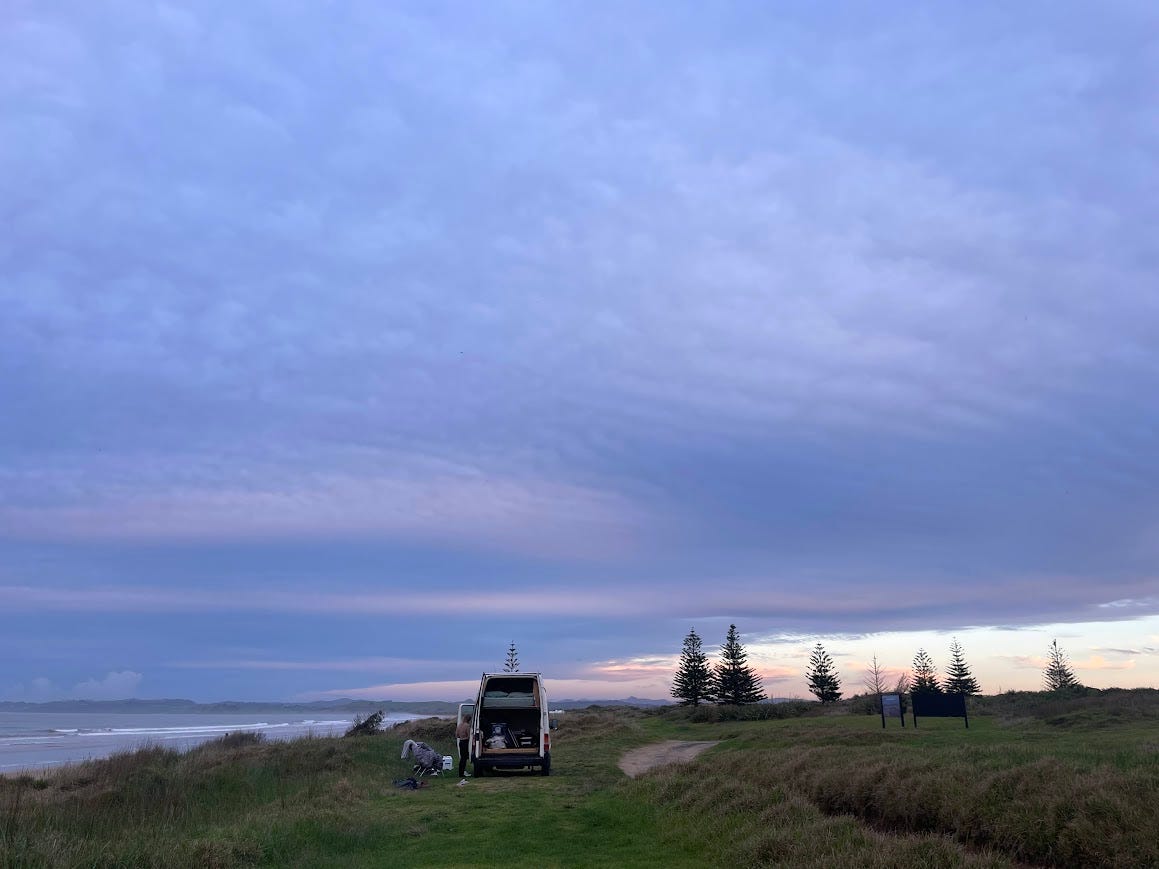
Upon arrival, we got out to use one of the shoe washing stations we’ve found to be common at reserves in New Zealand. These fixtures prevent bacteria (in this case, kauri dieback) that kill native trees from catching a ride cross-country on our sneakers. We were then greeted by two of the main volunteers on the wetland restoration project. The reserve is an example of the rare dune lake ecosystem, where sand forms a shallow basin in which rain collects to form a shallow lake/wetland. Our volunteer hosts walked us around the trail that surrounds the wetland. They pointed out native species, like giant kauri trees that used to cover this region prior to deforestation. Kauri grow up to 164 feet tall and live for up to 2,000 years! They also pointed out the invasive plants we would be weeding that week, which at first felt pretty intimidating! It felt more difficult and less satisfying to squat in the woods trying to spot a tiny little invasive plant (that may look similar to other, desired, plants) than it had to hike a trap line. But by the end of the week, I couldn’t not see a wattle or climbing asparagus, and found weeding to be really relaxing and satisfying.
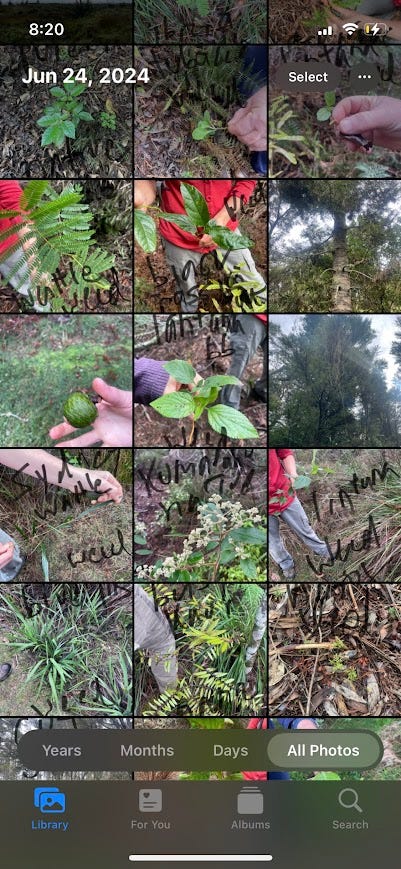
The wetland conservation project felt like a really nice complement to our trapping work to get a more holistic picture of conservation efforts in New Zealand. As I mentioned in our trapping post, habitat loss is one of the biggest threats to native animals. Introduced/invasive plants often smother and out-compete native plants. Native plants are the best habitat and shelter for native animals, and a threat to this complementary relationship is a threat to the entire ecosystem. While eradicating invasive species like rats and possums is a big project, eradicating invasive plants feels like an even bigger one.
Our volunteer hosts were quick to point out that this is a long-term, gradual project. They use a combination of hand-weeding and sprays, as too much spray would threaten native species, but hand-weeding alone would be simply unachievable. And continued maintenance is key! There’s no point starting a big weeding effort if you are just going to let it get out of control again. Each year, they are able to re-plant more native trees. As they do so, more and more are naturally spreading seeds and expanding. Weeding is essential to make sure these saplings aren’t outcompeted. Ultimately, the goal is to restore the wetland with native plants and reintroduce native birds. However, you can’t reintroduce the birds too quickly, or they will end up serving as spreaders of the seeds of invasive plants! They also won’t have enough native bush on which to survive. We appreciated getting to be involved a project that is very much in the middle of the process. Who knows how long until it becomes a national success story?
Life Off-Grid
Most of the time, staying in an off-grid cabin might be more primitive than what we are used to. But since we are living in a van, it was an upgrade! We luxuriated in the opportunity to spread ourselves out for the week. While we did a little bit of exploring in the area (to Cape Reinga, the Giant Sand Dunes, and 90-Mile Beach), we appreciated the opportunity to slow down our travels.
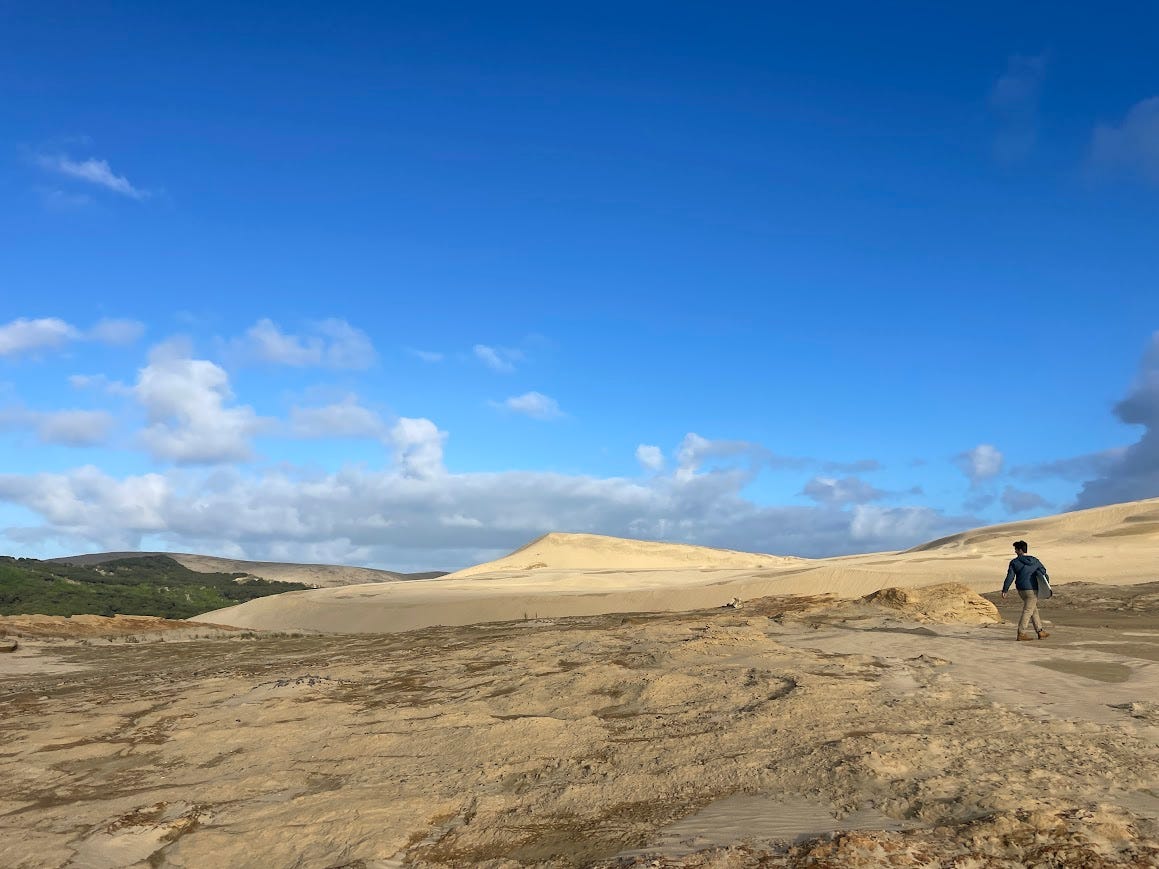
After our introduction to the property, we were left to our own devices. Each morning, Chris would wake up first and get the wood-burning stove going. Then we’d have breakfast and do a little reading or play a game of Bananagrams. We’d head out into the forest to weed for a few hours before and after lunch before enjoying the rest of our afternoon. Chris also chopped our firewood and collected pinecones for the stove that heats up the shower! In the evenings, we spent time relaxing and reading a lot of books in our off-grid cabin. Although our cabin had solar-powered lighting, we opted for 10-hour candles stuck in old wine bottles for the vibes. Since we didn’t have access to plugs for our phones, we also stuck nails in candles to measure the passage of time!
While I have to give most of the credit to Chris for doing the essential tasks to keep us well and warm, we both really enjoyed the rituals of doing life tasks that might normally be considered an inconvenience. Chris joked that all it took was one day of chopping firewood before he started singing John Denver’s “Thank God, I’m A Country Boy.”
Right after our stay in the cabin, we stumbled across a copy of the bestselling book Into the Wild. We were struck by how much the desire to live in the woods away from society is linked to this myth of rugged individualism, of depending on no one else. For us, being off-grid heightened our awareness of our interdependence. On nature, certainly, for the rainwater in our taps, the sun providing our lights, and the wood keeping us warm. But also on the rest of society! We may not have been hooked up to the gas lines for our little three-burner skeleton stove, but that big fuel tank had to come from somewhere. One of our volunteer hosts had also brought us eggs from her chickens that we ate every morning! We concluded that we really liked the sustainable infrastructure and intentional pace of living off-grid, but value community too much to withdraw any further.
During our week in the cabin, I also read the loveliest little book by Ray Bradbury, Dandelion Wine. The grandfather makes an argument for not eliminating life’s little jobs like weeding, “because they bend you over and turn you away from all the people and the town for a little while and sweat you and get you down where you remember you got a nose again. And when you’re all to yourself that way, you’re really yourself for a little while; you get to thinking things through, alone.” In this recess year, I’ve stripped away many of my previous daily stressors, giving myself time and space to reflect and address the deeper roots of my anxiety. In the monotony of weeding and the quietness of long nights by the fire, I felt another layer of stress beginning to release.
From Carbon Footprint to Conservation: Confronting Climate Anxiety
I’ve played a game with myself ever since I learned how to drive. On a decline (without traffic), how long can I get the car to roll without using the accelerator? In the neighborhood I grew up in, I could coast the full 1.2 miles from the neighborhood entrance to my house, and sometimes even make it all the way up my driveway. I rarely consciously acknowledge that I’m doing this, but it’s what I think about in the long stretches of drive where our minds are on shuffle. While I know it ultimately has very little impact on our fuel consumption, it’s one of the obsessive little ways I try to manage the bigger thing I am constantly thinking about: climate anxiety and guilt.
I’ve been passionate about the climate movement since I was young. My friends in my high school climate club helped me take an undirected interest in sustainability to marching in DC against the Keystone Pipeline in the largest climate protest in U.S. history at the time. I have built much of my lifestyle, career, and personality around sustainable modes of transportation and consumption. And I genuinely find joy in doing these things! Rather than feeling like a sacrifice, choices like bike commuting and having a local CSA share positively contribute to my health and happiness. And there’s nothing, nothing, like riding a great train.
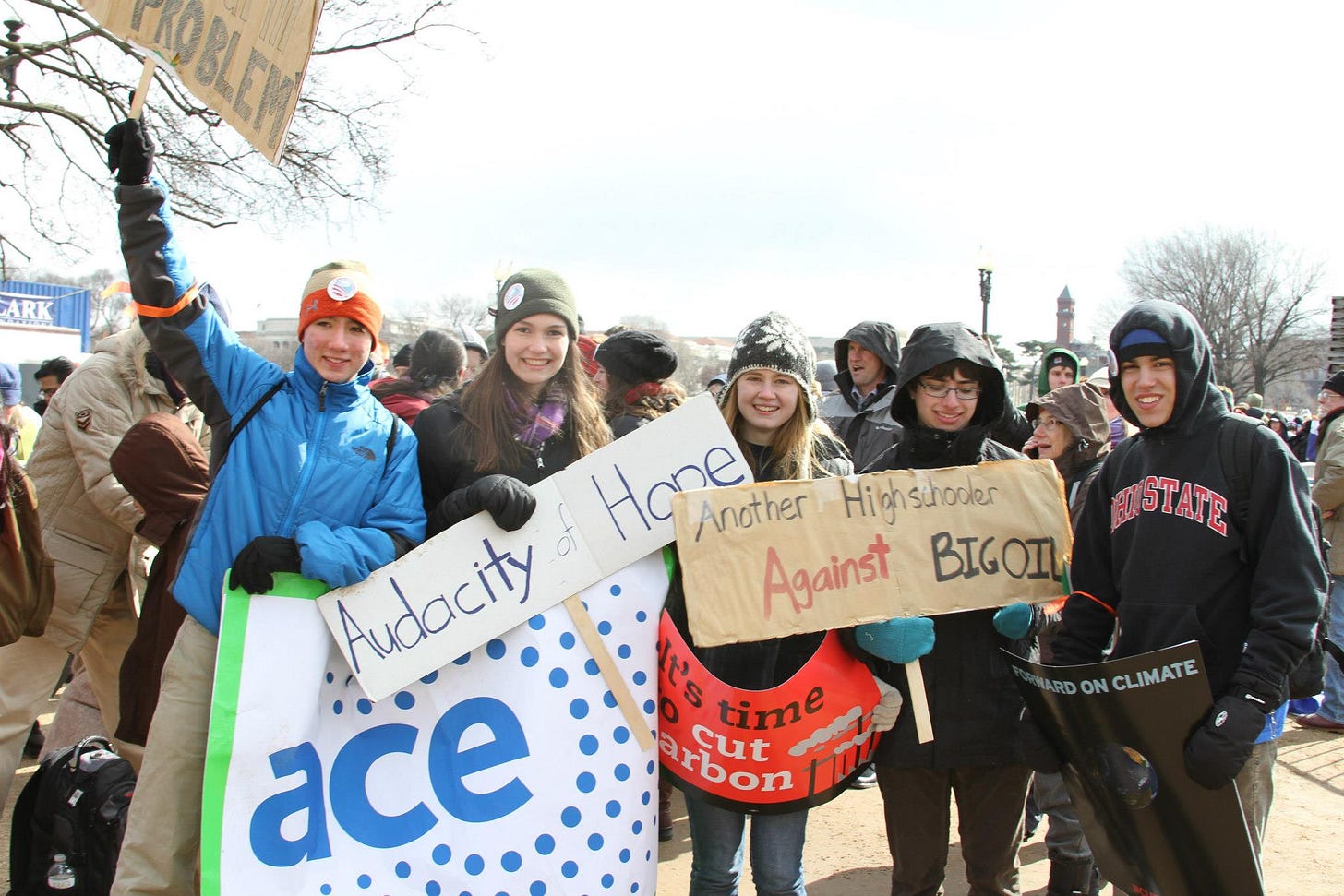
But in recent years, as the world continues to miss key targets to prevent climate catastrophe in my lifetime, caring about climate change has turned into an overwhelming level of climate anxiety. Described as chronic negative emotions related to climate change, climate anxiety is often associated with feelings of anger, guilt, sadness, fear, and hopelessness. Every single day, I think about the gas our van is guzzling, the super-long flights we’ve taken to be here, and the fact that some of the natural areas we are visiting are disappearing as a direct result of human impact.1 I have feelings of dread when I think about our climate future, and the ways that my energy-intensive lifestyle contributes to some of the worst predicted outcomes.
Climate anxiety is a reasonable response to an unstable present and uncertain future. At the same time, like any form of anxiety, it has to be managed. Unfortunately, my way of managing it has traditionally been a shame-inducing and ultimately ineffective obsession with the environmental impact of my daily actions. While there may have been times that I felt self-satisifed with more eco-friendly lifestyle choices, I haven’t been able to maintain all of them as my life circumstances have changed. Chris has to regularly remind me that the idea of a “carbon footprint” was created by oil companies to shift the responsibility of combating climate change from energy giants onto individuals. I often limit myself with these frameworks that “encourage us to imagine ourselves as consumers rather than citizens . . . [to] privatize our public spirits. . . [and] to change nothing but ourselves and merely implore the powerful to heed our wishes.”2
It’s understandable why so much of the climate movement and conversation centers around carbon. Organizers like Chris have done incredible work to connect people like me to collective actions that hold the biggest polluters accountable, which is a lot better than scrutinizing every personal decision within an unideal set of options! While I still value being a conscientious consumer, I haven’t found much hope in reducing global carbon emissions through reducing my own carbon emissions alone. Individual efforts do add up, but to address the climate crisis, we need them to multiply through collective action and organizing.
But as I mentioned in my last post, big structural changes do not always happen at a satisfying pace. We still have to live our daily lives while waiting for policy to catch up to advocacy. In the meantime, it’s taking action that generates hope – not the other way around! While living in a country where I can’t vote or call a representative, this is where I’ve found being involved in local conservation efforts to be really meaningful. Climate change and biodiversity loss are closely linked. While policy is as essential to protecting native species to limiting carbon emissions, we have seen so many examples in New Zealand of the immense impact of personal actions on the conservation movement. At our trapping jobs, the family who owned the farm has committed their land and efforts over the past 30 years, creating the conditions for the little blue penguin colony on Banks Peninsula survive and grow to one of the largest in New Zealand. Also on the Banks Peninsula, one botanist has been the driving force in restoring native bush in local reserves. And it’s a group of less than ten people who have made such incredible progress in restoring this Far North wetland, which might otherwise have just been lost like 90% of New Zealand’s wetlands.
The lens through which we understand a place informs our relationship and our perceived responsibility to that place. As an urban planner, I tend to observe the world through the built environment, history, and demographics. When I set out to learn more about local flora and fauna this year, it was a pretty surface-level resolution to enhance my appreciation of spending time in nature. Now, it’s hard to imagine how I ever moved through the world knowing so little about the natural environment around me. Of course, this is not a new idea. Indigenous peoples all over the world have long held relationship to the land as a central, sacred principle. In Māori culture, you introduce yourself first by your nearest mountain, then your nearest body of water, your iwi (tribe), your family, and, lastly, by your own name. In contrast, my relationship to the climate has often been one of assumed separation, of trying to do less, of attemping to minimize the harm of my existence on the earth and the people who bear the brunt of the climate crisis. I feel grateful for the opportunity to learn from the people and land here in New Zealand, and for the hope generated from doing more rather than less to know and be in a restorative relationship with the environment.
Moving On!
At the end of the week, the regional chapter had their monthly working bee at the wetland. This month, they were planting native tōtara trees! It was the perfect way to end the week and remind us why we spent all those hours doing the seemingly-Sisyphian task of pulling tiny weeds out of the bush.
After saying our goodbyes, we headed down to the Bay of Islands to the Waitangi Treaty Grounds, where the British and Māori signed a treaty that continues to shape the relationship between the Crown and Māori people. After a few days in sleepy off-season Russell, we drove to Rotorua, a town we had visited at the beginning of our trip. We mountain-biked one of New Zealand’s “Great Rides” in the Whakarewarewa Forest, which can only be described as epic. We both agreed our mountain biking days are only beginning. Since arriving in Taupō, we’ve been parking our van in the driveway of a wonderful local family. We spend our days pushing kids off an ice slide, so we’ll see if any deeper reflections manage to come out of that. In a week, we head to our volunteer gig at a bird sanctuary! Until then!
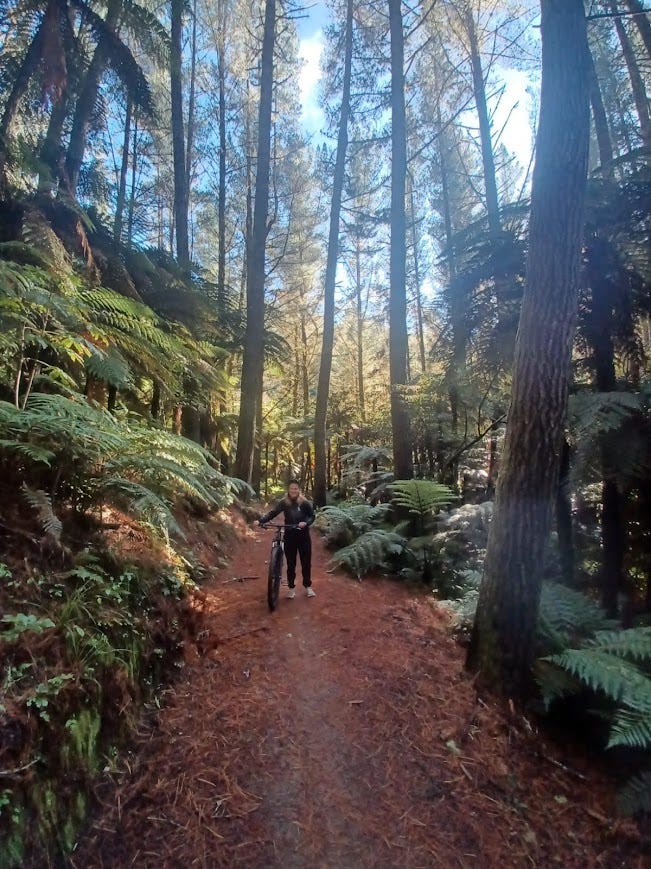
Don’t even get me started on articles like “10 Things to See in New Zealand Before They Disappear.” While I won’t deny that glaciers are receding at an alarming pace, saying that people should go get pics of the kauri trees, yellow-eyed penguins, or kakapo birds before they are (read: inevitably) gone feels insulting to conservationists actively working to prevent this outcome.
From Rebecca Solnit’s essay “Difficult Is Not the Same as Impossible,” which serves as the introduction to the book Not Too Late: Changing the Climate Story from Despair to Possibility. It’s a great collection of essays by climate activists and scientists that I recommend! It also includes a chapter listing major achievements of the climate movement that are a good reminder in moments of despair.

